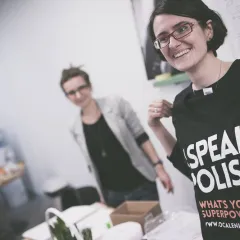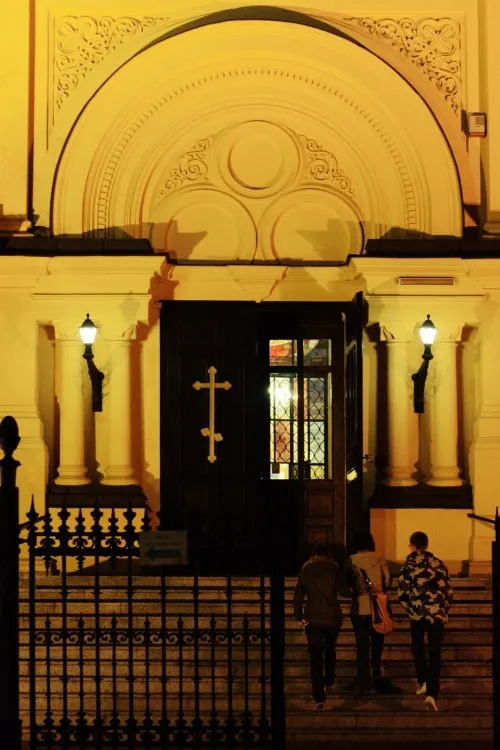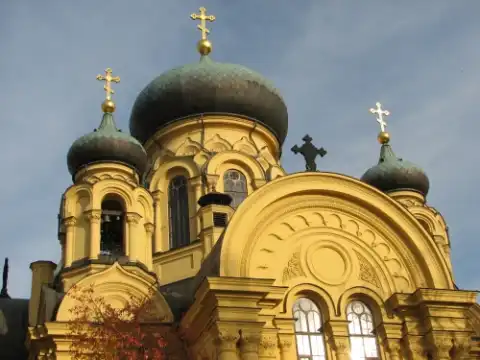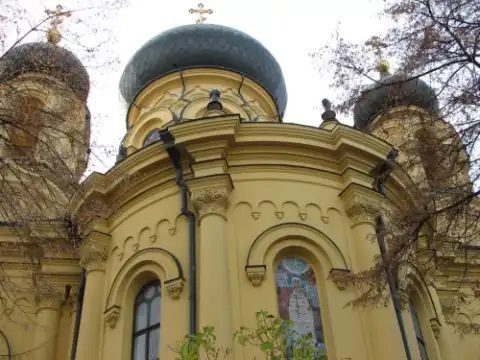Thinking about the content of this article devoted to Russians living in Warsaw, I wondered what to depict. I wanted to choose something interesting and unknown for the readers, something that would be the most characteristic for the Russian community, linked with the history of our city and integrated into its landscape. I reckon that the most recognizable symbols embedded in our subconscious, yet shrouded in mystery are Warsaw Orthodox Churches. Places where the community gathers to experience joy, or to sooth sadness, connecting not only Russians, but all followers of the Orthodox Church.They are open to all those who seek solace and endeavour to understand this religion and culture. So, I suggest that we take a stroll around Warsaw during which we will see the traces of the Orthodox Church. We willl also have the opportunity to notice how the history of these temples is inextricably linked with the history of our city - like Warsaw, they experienced ups and downs, destruction and reconstruction.
Lets start our saunter from an inconspicuous building located at Podwale Street 5. This is the oldest Orthodox church in Warsaw – Orthodox church of the Holy Trinity. In the early nineteenth century, Greek merchants living in Warsaw adapted that modest building to the needs of their liturgical observance. The plan was designed by renowned architect James Kubicki. After the World War I, Orthodox church of the Holy Trinity welcomed Russian Orthodox immigrants, who called it, after the name of the street, but also thanks to its appearance, " the cellar" ("Подвалка). During the Warsaw Uprising in 1944, the church shared the fate of the entire city – it was completely destroyed; battalion Gustaw had made their barricade in it. It was also here, where the vicar and his family were killed. The post-war fate of the Orthodox church of the Holy Trinity is also distinctive and symbolic – parish priest Alexander Subotin was murdered by the NKVD and the property was nationalized. While rebuilding the church, all traces of religious purpose of the building were eliminated. It was not until 2002, when it was returned to the Orthodox church believers, than the the ground floor was restored. It currently serves the academic members of Orthodox denomination. The only remnant of the pre-war design is the icon of the Virgin Mary Pochayiv. It is an interesting point that the church is open to all; the Warsaw community of the Coptic Church celebrates their services here.
Leaving the Orthodox church of the Holy Trinity I recommend to visit a nearby temple at Miodowa Street 16, the only Greek Orthodox church in Warsaw - Greek Orthodox Church of the Basilian Fathers, dedicated to the Assumption of the Blessed Virgin Mary and St. Josaphat - a bishop and a martyr. It was built between 1781-1784 according to the project of an architect Domenico Merlini, and now is counted as one of the most valuable monuments of the Warsaw classicism. Similarly to the Orthodox church of the Holy Trinity, it was completely destroyed during the Warsaw Uprising in 1944. After the war, thanks to believers' efforts, it was fully restored and now belongs to the community of Greek-Catholic church – a denomination which bridges the Orthodox and the Roman Catholic Church.
The next church I would like to introduce you is located in a short distance from the Greek Orthodox Church of the Basilian Fathers - on the opposite side of the Vistula, in Prague district at. Solidarity Avenue 52. Visible from afar, Saint Mary Magdalene Orthodox Church was designed by Nikolai Sychev. The building works, initiated by the Prince Vladimir Czerkawsky, started in 1867. The church is extremely characteristic for the landscape of Prague district; its location is not coincidental. It was built for the Russians residing in Warsaw, many of whom had lived near the
site, but also for many travellers coming from the Russian Empire and getting off on a nearby, built a few years earlier, Station St. Petersburg (now Vilnius Station). At that time, all passengers arriving from St. Petersburg changed trains to continue their travel to Western Europe at the Vienna Station, located at Jerusalem Avenue.
I advise a longer visit in the church and taking a closer look of this building – so typical of Orthodox sacral architecture. It was built in Byzantine style and planned in the form of a Greek cross, crowned with a high dome surrounded by four smaller domes, two of which would serve as bell towers. There are two churches in this building – in the lower (the chapel of the Passion) and in the upper section. Ascending the majestic stairs to the upper church, we can observe the typical internal division of the orthodox church – in the sanctuary you can find an altar, nave and a vestibule. The altar is separated from the nave by richly decorated iconostasis depicting the Orthodox evangelists, prophets and saints. A place for choir members singing during Orthodox church services is located above the vestibule. Over the major holidays believers flock to the incensed church which echoes with liturgical songs and prayers, and is lightened by candle flames flickering on the iconostasis.
In a completely different part of Warsaw – in the Wola district, at Wolska Street 140, there is another church – Orthodox church of St. John Climacus. Building this temple, designed by Vladimir Pokrowsky, started in 1902. It was erected with characteristic white bricks on the plan of a Greek cross, surmounted by a dome which makes an impression of modesty, but also extreme subtleness. The church was designed in the Old Russia style referring to Russian sacral architecture. Like Saint Mary Magdalene Orthodox Church, it accomodates two churches - the lower (Church of the blessed Jerome Strydonski and prophet Elijah) and the upper section. The walls of the lower church are decorated with frescos painted by renowned artist Jerzy Nowosielski.
After visiting this church I encourage you to go to the nearby Orthodox cemetery. It was founded after the fall of November Uprising in the redoubt 56 (of Joseph Sowinski). The St. Lawrence Church was transformed into the Orthodox Church of Our Lady of Vladimir, whose function was taken over by the church of St. John Climacus (built in 1905). The cemetery is divided into several sections - the location of graves depended on the social status of deceased people. Generals and their loved ones, officers and clergy, officials, wealthy merchants and university lecturers were buried in the most important part. Soldiers and townspeople had their graves in the subsequent section, the lowest was earmarked for the poor and those who died in hospitals. In the 1960s graves from cemetary in Grochów were moved here. On the west side of the cemetary, in its immediate vicinity, there is a worthy of attention, but still very little-known cemetery of Karaites community.
I encourage those who are not tired yet, to visit two more temples which were built for the needs of the Orthodox Church, and now serve the followers of other denominations.
Puławska Street 2a is characteristic for the high church bell tower. The building was designed by Victor Junosza-Piotrowski and built in 1902 on the boundaries of the Mokotow Field where the army units stationed. Originally it was a garrison Church of Saints Peter and Paul for Keksholmski Infantry Regiment, which stationed at that time in the Pulawy barracks. After World War I, in 1921, the building was adapted by Augsburg Evangelical Church (Church of the Ascension Parish). In 1931 a thorough reconstruction of its design under supervision of Edgar Norverth'a was started. As a result the typical design elements of the Orthodox Church were removed.
Another example of the garrison church is the temple located at Szwoleżerów Street 2nd. The Blessed Martyna Orthodox Church was built in 1906, according to the project of Leontia Benosi for the soldiers of His Majesty Uhlans Regiment, who stationed nearby. Like the church in Wola it was built in the Old Russia style, on the plan of a Greek cross, with the characteristic white brick, rich portals and window frames decorations. During the interwar period, the church was transformed into (for example, the characteristic dome was removed) the first Roman Catholic Garrison church of the Jozef Pilsudski Regiment of Light Cavalry. After World War II, the temple was submitted to the Polish Catholic Church and serves this community so far as the Cathedral of the Holy Spirit.
I hope that my description will encourage all Warsaw fans to explore the churches for themselves -buildings shrouded in mystery, yet open to every passer-by.
Text by Katya Sokolova-Zyzak, Staszek Zyzak, November 2009
Translated by Pola Rutkowska









